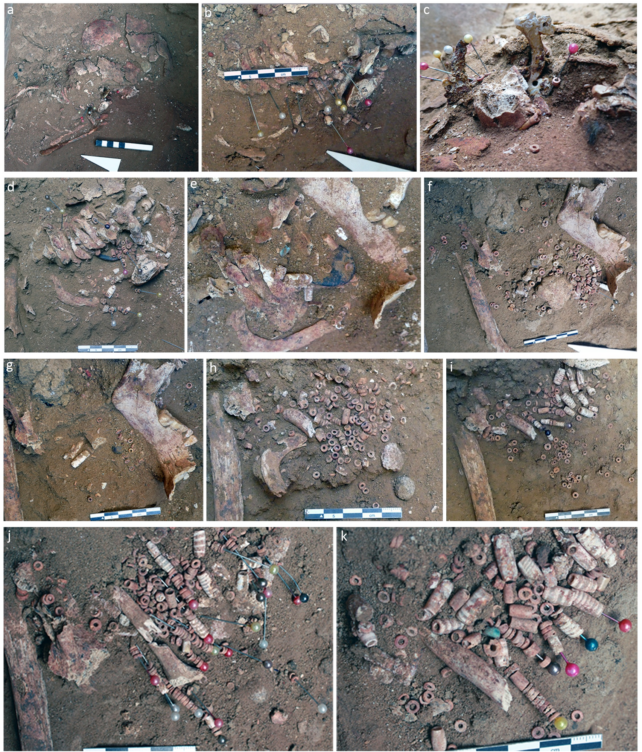Archaeologists have found the body of a child from around 9,000 years ago buried with thousands of beads in what is now Jordan.
Based on the shape of the child’s jaw, she was probably a girl roughly 8 years of age, according to an international team led by archeologist Hala Alarashi from Côte d’Azur University in France.
The bones that are left have been so damaged by time that little can be said about the child’s lifestyle.
The beads are one of the only clues as to who she was and what her society’s culture was like, suggesting that the people who once lived in this Neolithic village, known as Ba`ja, took great care to bury their children.
Of the more than 2,500 beads counted in the grave – some made of calcite, some made of turquoise, and some made of hematite – most were stained red, and they spilled across the child’s chest and neck.
Among the mess, there was a faint yet perceptible pattern. For every series of 10 beads shaped like discs, researchers noticed two nearby beads shaped like tubes.
Such a careful arrangement would have required the beads to be strung, possibly sewn into the child’s clothing or hung on a body part.
Behind the child’s neck, Alarashi and her team found the answer. Here, they uncovered a mother-of-pearl ring and a double-perforated pendant with several beads still connected.
Bead by bead, scientists have put the spectacular ornament made with multiple strands of carefully placed beads back together.
The multi-stranded pendant reconstructed. (Alarashi et al., PLOS ONE, 2023)
Ba`ja was probably occupied between 7400 and 6600 BCE, and even though the village is small, it is dense with archaeological remains. It’s only possible to reach the mountainous plateau by traveling through a series of winding gorges and vertical rock formations.
Still, not everyone who lived in this ancient village was buried there.
Only a few graves have been found beneath Ba`ja’s houses,and most of these contain infants and children, buried with numerous grave goods.
 Field pictures showing the distribution of the beads. (Alarashi et al., PLOS ONE, 2023)
Field pictures showing the distribution of the beads. (Alarashi et al., PLOS ONE, 2023)
In 2018, archaeologists found the grave of the 8-year-old girl under a room in the ancient village. The results of their meticulous excavation have now been published.
Alarashi and colleagues say it is obvious that the beads this child was buried with were “part of an ornament that has collapsed and disorganized gradually after the decomposition of the body”.
They add that her necklace is unlike any other creation found in the Levant, a historical region that stretched from the Eastern Mediterranean to West Asia.
The harmony of the colors and the careful symmetry of the beads speak of great wealth and prosperity.
But the true masterpiece of the ornament, researchers say, is the mother-of-pearl ring. It is large and extremely delicate and was probably once iridescent. Its surface is carefully and skillfully engraved with fine patterns that resemble lace or filigree.
“The aesthetic sensibility,” the authors of the study write, “is indisputable”.
The huge volume of beads, their complex organization, and their harmony and beauty are reminiscent of later ornaments that show up in Mesopotamia and Egypt.
In this much older Levant village, the necklace stands out.
“Our in-depth analysis of the assemblage has allowed us to reimagine one of the oldest and most impressive Neolithic ornaments, believed to have been created to endow a highly distinguished 8-year-old child of the community,” the archaeologists write.
“Despite its elaborate design, such a necklace was not created for exchange or trade purposes but was rather a part of the child’s burial, serving as a significant testament to the cultural practices of the time.”
The necklace is now on display at the New Museum of Petra in Jordan.
The study was published in PLOS ONE.

